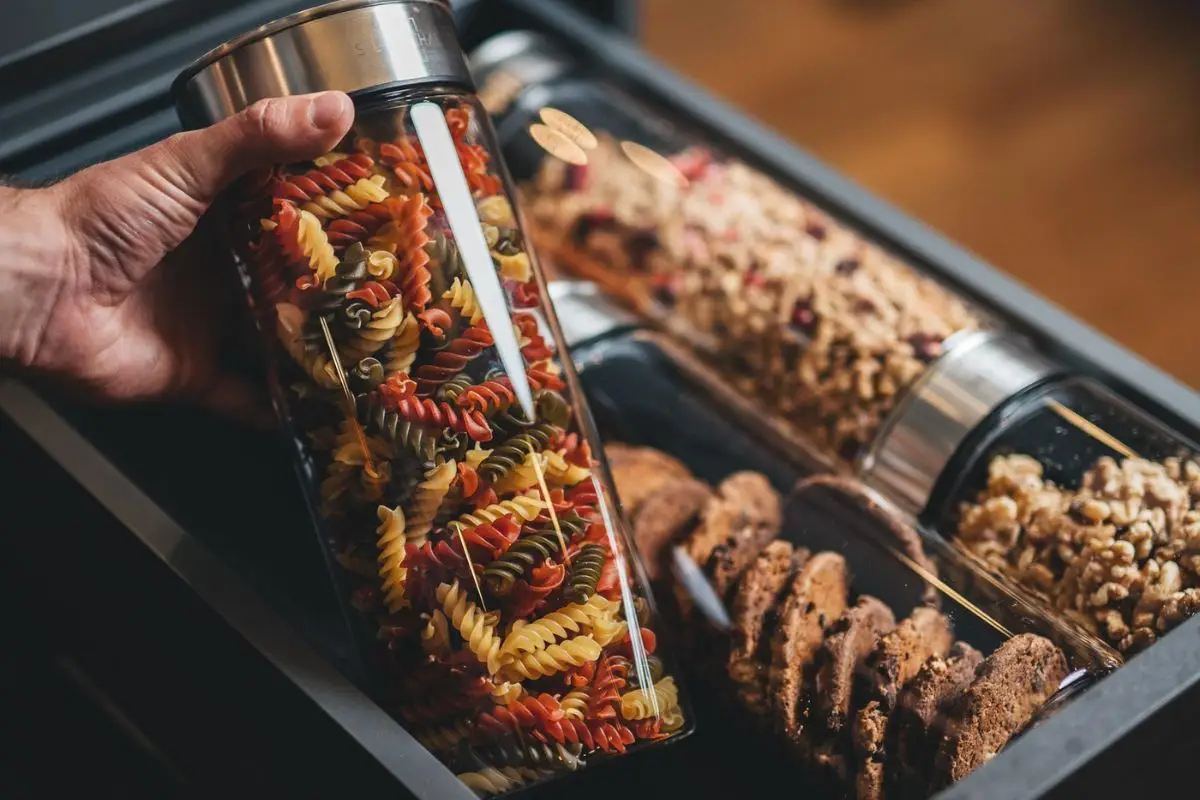If you want to better organize your supplies, you can’t avoid the question: What are the right storage containers for me? We’ll help you find the right containers and the right size for you among the wide selection of different containers available.

Tip 1: Better safe than sorry!
A certain amount of extra space is always advantageous. When in doubt, choose the larger jar rather than the smaller one. This way, you can easily fill in the newly purchased package, even if a small remainder of the previous content is still there. Because let’s be honest: is there anything more frustrating than when the last bit doesn’t fit into the jar?
Tip 2: Planning is half the battle
Grab a measuring tape and explore the hidden corners of your kitchen. How many jars can fit side by side in your favorite cabinet? What heights do your shelves allow? Every centimeter counts! Think not only horizontally but also vertically! Our storage containers are stackable. The slightly raised edge ensures that your jars stand securely – no more sliding around! This not only creates order but also adds a fascinating visual element to your kitchen. With this well-thought-out approach, your food storage becomes not only practical but also a real eye-catcher in your kitchen. Let your creativity run wild and enjoy the new clarity!
Tip 3: Calculate the space in your cabinet or drawer
With the simple formula length x width, you get your base area – the starting point for your organization journey! With SILBERTHAL containers, planning becomes child’s play: Thanks to the uniform diameter of 10 cm, you can easily calculate how many jars can fit side by side. Don’t forget to plan generously! Allow enough space in between so you can easily reach each jar.
Tip 4: Weight is not volume
On food packaging, you’ll normally find the weight in grams, while storage jars are categorized by their volume in milliliters or liters. How does this fit together? With foods, it’s unfortunately not as simple as with water, where weight and volume are identical. A kilo of flour, for example, corresponds to about 1.4 liters.
To make calculations easier for you, we’ve put together a useful table listing the appropriate containers for different foods.
What is bulk density?
Bulk density is a term for the density of a granular bulk material. It indicates how much volume a poured pile of lentils, sugar, or pasta needs, including the hollow spaces created in the process. Depending on the shape, texture, and density of the food supplies, the bulk density differs.
Why is bulk density important?
By pouring dry and granular foods, hollow spaces form between the individual pieces. Because of the transfer, we therefore need more space. If we know the bulk density, we can adjust the size of the storage jars accordingly.
How can I determine which containers I need?
There is a simple method to find out in your kitchen which size you need for a specific amount of supplies. All you need is a scale and a measuring cup with milliliter display.
Here’s how to proceed:
- Place the measuring cup on the scale. It should show 0g with the cup on top.
- Now fill 100g of your supplies into the measuring cup.
- Then you can read from the measuring cup how many milliliters 100g of your supplies need.
- Now you can calculate the milliliters independently. For example, double (for 200g of supplies), triple (for 300g of supplies), quintuple (for 500g of supplies) or multiply by ten (for one kilo of supplies).
With this simple method, you can quickly and easily determine the density of foods and adjust the size of your storage jars accordingly. This way, you always have the right amount of food at hand and avoid unnecessary waste of space.
List of Food Items and Their Matching Storage Jars
We have tested the volume of the listed food items for you.
400 ml Storage Jar
- Peanuts (200g)
- Hazelnuts (160g)
- Almonds (200g)
- Coconut chips (100g)
- Cookies
- Raisins (200g)
- Coarse sea salt (300g)
700ml Storage Jar
- Chia seeds (300g)
- Dates (250g)
- Peanuts (300g)
- Dried apricots (250g)
- Dried plums (250g)
- Gummy bears (200g)
- Hazelnut kernels (150g)
- Pumpkin seeds (250g)
- Flaxseed (250g)
- Powdered sugar (250g)
- Roasted onions (150g)
- Salt (500g)
- Walnuts (200g)
1000ml Storage Jar
- Bulgur (500g)
- Couscous (500g)
- Lentils (500g)
- Loose tea (250g)
- Almonds (500g)
- Breadcrumbs (500g)
- Quinoa (400g)
1300ml Storage Jar
- Ground coffee (500g)
- Cocoa (500g)
- Short pasta (e.g., Fusilli) (500g)
- Rice (1kg)
- Sugar (1kg)
1500ml Storage Jar
- Granola (500g)
- Oatmeal (500g)
- Whole coffee beans (500g)
- Crunchy muesli (600g)
- Flour (1kg)
1700ml Storage Jar
- Protein powder (1kg)
- Spaghetti (500g)
Help Us Expand the Guide!
Do you already have experience with our jars and know exactly how many grams of quinoa, lentils, or raisins fit in a specific storage jar?
Then please send us a short message with more detailed product information (e.g., fine oatmeal), the filling amount in grams, and your personal container recommendation. This way, we can expand the storage jar guide together and help each other find the right jar for every type of food!
